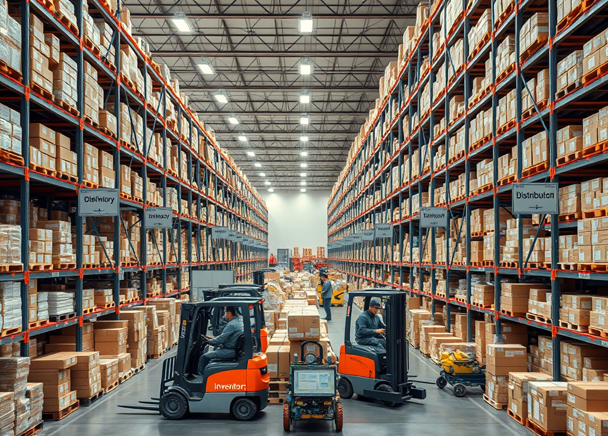New Logistics Terms in 2025
9300 12.06.2025, 10:05 0 Обучение Логистика
The logistics landscape is in constant motion, driven by technological advances, changing consumer expectations, and global economic shifts. By 2025, the language used in the industry will reflect these changes, including new terms and reinterpreting existing ones. In this article, we will look at new terms in the field of freight transportation of the future that will help you navigate the changing vocabulary of logistics.
1. Predictive logistics and terminology driven by artificial intelligence:
Demand detection: In addition to simple forecasting, the demand detection system uses real-time data from various sources (social media, weather conditions, point of sale data), which allows you to predict fluctuations in demand with unprecedented accuracy. Expect to hear more about dynamic inventory optimization and active route planning using this technology.
Autonomous Yard Management (AYM): As automation penetrates deeper into yards, AI-powered AYM will become commonplace. This includes terms such as intelligent trailer detection, automatic gate control, and real-time trailer monitoring, all of which help optimize yard operations and reduce downtime.
Route optimization using artificial intelligence: In addition to basic route planning, this includes algorithms that dynamically adjust routes based on real-time traffic data, weather conditions, and even predicted disruptions. Terms such as constraint-based routing and multimodal optimization will become widespread.
2. Sustainable development and eco-friendly logistics.:
Scope 3. Carbon emissions tracking: The focus will be on indirect emissions across the supply chain. Expect to hear about carbon footprint mapping, sustainable sources certification, and life cycle Assessment (LCA) to make informed decisions.
Reverse logistics as a tool of a closed-loop economy: Returned goods are no longer just waste, they are a valuable resource. The focus will be on remediation networks, repair centers, and closed supply chains to maximize resource utilization.
Alternative Fuel Usage Indicator (AFAR): This indicator will become increasingly important as companies seek to reduce dependence on fossil fuels. Expect discussions on the integration of electric vehicle (EV) fleets, hydrogen fuel cell technology, and the search for biofuel sources.
3. Hyperpersonalization and updates of the "last mile" delivery system.:
Hyperlocal Order Fulfillment (HLF): A network of micro-fulfillment centers is required to meet the demand for instant satisfaction. Terms like "Dark Shops," mobile fulfillment units (MFUs), and drone delivery zones will spread as companies strive for same-day or even same-hour delivery.
Dynamic allocation of delivery time: Unlike static time slots, dynamic allocation of time uses real-time information to optimize delivery routes and provide customers with more flexible options. Expect to encounter terms such as real-time arrival time updates, dynamic schedule changes, and precise delivery times.
Contactless Delivery Protocols (CDP): After the pandemic, the focus will be on contactless delivery. Innovations such as the integration of smart locks, artificial intelligence parcel recognition, and autonomous delivery robots will help improve last-mile delivery safety and efficiency.
4. Vocabulary on Blockchain and Supply Chain Security:
Tracing the origin: Ensuring the authenticity and origin of the goods will be of paramount importance. Terms such as distributed ledger technology (DLT), immutable records, and smart contracts will become an integral part of maintaining the integrity of the supply chain.
Counterfeit Detection Protocols (CDPs): Blockchain can play a crucial role in detecting and preventing counterfeit goods. Expect to hear about digital twins, anti-counterfeiting, and blockchain-based authentication.
The Supply Chain Resilience Index (SCRI) is an indicator that quantifies the supply chain's ability to withstand disruptions. It will include factors such as supplier diversification, risk mitigation strategies, and real-time monitoring tools.
5. Definitions are dominated by data and analytics:
Prescriptive Analytics in Logistics: Going beyond descriptive and predictive analytics, prescriptive analytics will provide practical recommendations for optimizing logistics operations. Terms such as simulation modeling, scenario planning, and automated decision-making will become more common.
Real-time data streaming and integration: The ability to collect and analyze data from various sources in real time will be crucial. Expect to hear about IoT sensor networks, API connectivity, and Data Lake architectures.
Logistics Control Tower 2.0: Based on basic visibility dashboards, the control tower of the future will operate based on artificial intelligence, proactively and predictively. Terms such as anomaly detection, automated warning systems, and performance optimization mechanisms will play a central role in its functionality.
Conclusion:
The logistics landscape of 2025 will be shaped by technology, sustainability considerations, and ever-increasing consumer demands. Understanding the evolving language of logistics – from algorithms driven by artificial intelligence to sustainable practices and advanced data analytics - is crucial in order to stay ahead of the curve and confidently navigate the future of trucking. By applying these new conditions and technologies, enterprises can improve the efficiency, sustainability and rational use of their supply chains, paving the way for a more interconnected and optimized logistics ecosystem.
Logistics Lessons from Holding Marketplace
Подписка на Новости
При оформлении подписки на новые статьи Вы будете два раза в месяц получать на Ваш адрес электронной почты письмо о выпуске Logistic Services в России с информацией о Новых Статьях, Логистических компаний размещенных на сайте за последние две недели.
Новости по теме
Комментарии (0)
добавить комментарийДобавить комментарий
показать все комментарииПоследние Новости
показать еще© Project Company Holding Marketplace - 2025